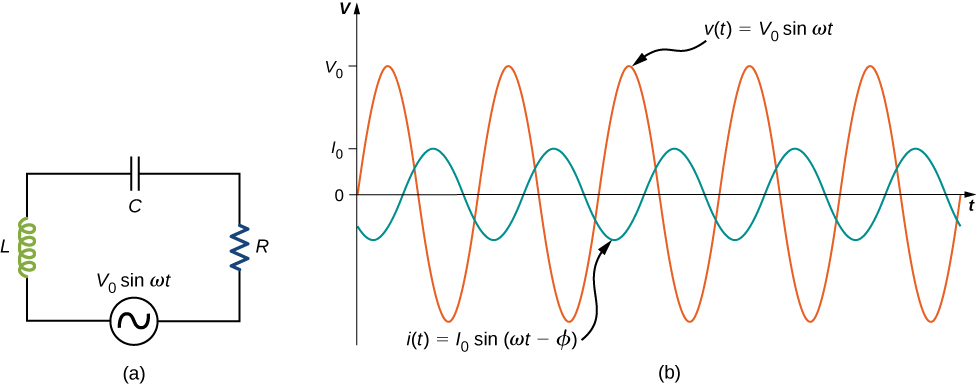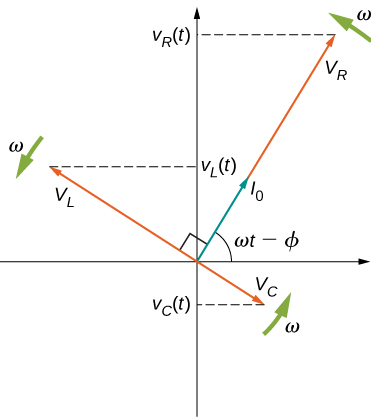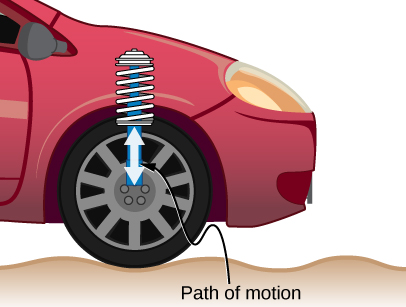10.10: Application - RLC Series Circuits with AC
- Last updated
- Oct 3, 2024
- Save as PDF
- Page ID
- 103041
( \newcommand{\kernel}{\mathrm{null}\,}\)
Learning Objectives
By the end of the section, you will be able to:
- Describe how the current varies in a resistor, a capacitor, and an inductor while in series with an ac power source
- Use phasors to understand the phase angle of a resistor, capacitor, and inductor ac circuit and to understand what that phase angle means
- Calculate the impedance of a circuit
The ac circuit shown in Figure 10.10.1, called an RLC series circuit, is a series combination of a resistor, capacitor, and inductor connected across an ac source. It produces an emf of
v(t)=V0sinωt.

Since the elements are in series, the same current flows through each element at all points in time. The relative phase between the current and the emf is not obvious when all three elements are present. Consequently, we represent the current by the general expression
i(t)=I0sin(ωt−ϕ),
where I0 is the current amplitude and ϕ is the phase angle between the current and the applied voltage. The phase angle is thus the amount by which the voltage and current are out of phase with each other in a circuit. Our task is to find I0 and ϕ.
A phasor diagram involving i(t), vR(t), vC(t), and vL(t) is helpful for analyzing the circuit. As shown in Figure 10.10.2, the phasor representing vR(t) points in the same direction as the phasor for i(t); its amplitude is VR=I0R. The vC(t) phasor lags the i(t) phasor by π/2 rad and has the amplitude VC=I0XC. The phasor for vL(t) leads the i(t) phasor by π/2 rad and has the amplitude VL=I0XL.

At any instant, the voltage across the RLC combination is vR(t)+vL(t)+vC(t)=v(t), the emf of the source. Since a component of a sum of vectors is the sum of the components of the individual vectors—for example, (A+B)y=Ay+By - the projection of the vector sum of phasors onto the vertical axis is the sum of the vertical projections of the individual phasors. Hence, if we add vectorially the phasors representing vR(t), vL(t), and vC(t) and then find the projection of the resultant onto the vertical axis, we obtain
vR(t)+vL(t)+vC(t)=v(t)=V0sinωt.
The vector sum of the phasors is shown in Figure 10.10.3. The resultant phasor has an amplitudeV0 and is directed at an angle ϕ with respect to the vR(t), or i(t), phasor. The projection of this resultant phasor onto the vertical axis is v(t)=V0sinωt. We can easily determine the unknown quantities I0 and ϕ from the geometry of the phasor diagram. For the phase angle,
ϕ=tan−1VL−VCVR=tan−1I0XL−I0XCI0R,
and after cancellation of I0, this becomes
ϕ=tan−1XL−XCR.
Furthermore, from the Pythagorean theorem,
V0=√V2R+(VL−VC)2=√(I0R)2+(I0XL−I)XC)2=I0√R2+(XL−XC)2.

The current amplitude is therefore the ac version of Ohm’s law:
I0=V0√R2+(XL−XC)2=V0Z,
where
Z=√R2+(XL−XC)2
is known as the impedance of the circuit. Its unit is the ohm, and it is the ac analog to resistance in a dc circuit, which measures the combined effect of resistance, capacitive reactance, and inductive reactance (Figure 10.10.4).

The RLC circuit is analogous to the wheel of a car driven over a corrugated road (Figure 10.10.5). The regularly spaced bumps in the road drive the wheel up and down; in the same way, a voltage source increases and decreases. The shock absorber acts like the resistance of the RLC circuit, damping and limiting the amplitude of the oscillation. Energy within the wheel system goes back and forth between kinetic and potential energy stored in the car spring, analogous to the shift between a maximum current, with energy stored in an inductor, and no current, with energy stored in the electric field of a capacitor. The amplitude of the wheel’s motion is at a maximum if the bumps in the road are hit at the resonant frequency, which we describe in more detail in Resonance in an AC Circuit.

Problem-Solving Strategy: AC Circuits
To analyze an ac circuit containing resistors, capacitors, and inductors, it is helpful to think of each device’s reactance and find the equivalent reactance using the rules we used for equivalent resistance in the past. Phasors are a great method to determine whether the emf of the circuit has positive or negative phase (namely, leads or lags other values). A mnemonic device of “ELI the ICE man” is sometimes used to remember that the emf (E) leads the current (I) in an inductor (L) and the current (I) leads the emf (E) in a capacitor (C).
Use the following steps to determine the emf of the circuit by phasors:
- Draw the phasors for voltage across each device: resistor, capacitor, and inductor, including the phase angle in the circuit.
- If there is both a capacitor and an inductor, find the net voltage from these two phasors, since they are antiparallel.
- Find the equivalent phasor from the phasor in step 2 and the resistor’s phasor using trigonometry or components of the phasors. The equivalent phasor found is the emf of the circuit.
Example 10.10.1: An RLC Series Circuit
The output of an ac generator connected to an RLC series combination has a frequency of 200 Hz and an amplitude of 0.100 V. If R=4.00Ω,L=3.00×10−3H, and C=8.00×10−4F, what are (a) the capacitive reactance, (b) the inductive reactance, (c) the impedance, (d) the current amplitude, and (e) the phase difference between the current and the emf of the generator?
Strategy
The reactances and impedance in (a)–(c) are found by substitutions into Equation 15.3.8, Equation 15.3.14, and Equation ???, respectively. The current amplitude is calculated from the peak voltage and the impedance. The phase difference between the current and the emf is calculated by the inverse tangent of the difference between the reactances divided by the resistance.
Solution
- From Equation 15.3.8, the capacitive reactance is XC=1ωC=12π(200Hz)(8.00×10−4F)=0.995Ω.
- From Equation 15.3.14, the inductive reactance is XL=ωL=2π(200Hz)(3.00×10−3H)=3.77Ω.
- Substituting the values of R, XC, and XL into Equation ???, we obtain for the impedance Z=√(4.00)2+(3.77Ω−0.995Ω)2=4.87Ω.
- The current amplitude is I0=V0Z=0.100V4.87Ω=2.05×10−2A.
- From Equation ???, the phase difference between the current and the emf is ϕ=tan−1XL−XCR=tan−12.77Ω4.00Ω=0.607rad.
Significance
The phase angle is positive because the reactance of the inductor is larger than the reactance of the capacitor.
Exercise 10.10.1
Find the voltages across the resistor, the capacitor, and the inductor in the circuit of Figure 10.10.1 using v(t)=V0sinωt as the output of the ac generator.
Solution
vR=(V0R/Z)sin(ωt−ϕ); vC=(V0XC/Z)sin(ωt−ϕ+π2/)=−(V0XC/Z)cos(ωt−ϕ);
vL=(V0XL/Z)sin(ωt−ϕ−π/2)=(V0XL/Z)cos(ωt−ϕ)


